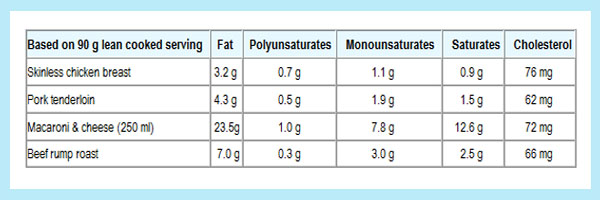Health Pages
TEST YOUR FAT I.Q.
TEST YOUR FAT I.Q.
What do you know about Food Guide to Healthy Eating and the fat issue?
Try this simple test to see what you know about fat and if your eating habits reflect the recommendations of Food Guide to Healthy Eating. Check out for answers and explanations. Find scoring at the bottom of the page.
1. Food Guide to Healthy Eating tells you to eat less fat because:
a) fat is bad for your health
b) People today eat too much fat
c) eating fat has been linked to some diseases
d) all of the above
2. Fat is:
a) an essential part of your diet
b) a principal source of energy
c) the carrier of Vitamins A, D, E and K
d) all of the above
3. Saturated fat:
a) has been linked to higher blood cholesterol levels
b) is found only in foods of animal origin
c) is usually liquid at room temperature
d) all of the above
4. Food Guide to Healthy Eating says you should:
a) eat as much meat, poultry and fish as you please
b) eat leaner meats, poultry and fish
c) eat less meat, poultry and fish
d) not eat meat, poultry and fish
5. Most of the fat in what we eat comes from:
a) dairy products
b) sweets and snacks (chocolate bars, pastries, baked goods, etc.)
c) meat
d) fats and oils (margarine, salad dressing, mayonnaise, etc.)
6. Which of the following servings has the least fat?
a) skinless chicken breast
b) pork tenderloin
c) macaroni and cheese
d) beef rump roast
7. Which of the following servings has the least dietary cholesterol?
a) skinless chicken breast
b) pork tenderloin
c) macaroni and cheese
d) beef rump roast
8. To meet Nutrition Recommendation that we get no more than 30% of total calories from fat, an average woman could have about:
a) 10 g of fat a day
b) 30 g of fat a day
c) 50 g of fat a day
d) 60 g of fat a day
9. A good low fat way to prepare meat is to:
a) fry
b) broil
c) bread
d) sauté
10. A fat-free diet is good for your health.
True
False
11. Your body needs an average of 50 nutrients every day.
True
False
12. Cutting out meat is a good way to eat less fat.
True
False
RomWell Health Pages - Disclaimer
Our pages are created to provide medically accurate information that is intended to complement, not replace or substitute in any way the services of your physician. Any application of the recommendations set forth in the following pages is at the reader's discretion and sole risk. Before undergoing medical treatment, you should consult with your doctor, who can best assess your individual needs, symptoms and treatment.ANSWERS AND EXPLANATIONS
Multiple Choice Answers:
1. (b) We do need fat, but most of us eat too much. Americans currently eat about 38% of their total calories as fat: Most health & welfare guides recommends this be reduced to 30%. Eating too much fat has been linked to some diseases.
2. (d) Fat is essential for a healthy body. It supplies energy, fat-soluble vitamins and essential fatty acids. In fact an average woman can have about 60 g of fat a day; a man, about 80 g.
3. (a) A high intake of saturated fat is one of many factors linked with a high blood cholesterol level. Saturated fat is found not only in foods of animal origin but in some foods of vegetable origin such as margarine and shortening. It is hard at room temperature. The simplest way to reduce saturated fat is to cut back on all fat.
4. (b) Choosing leaner meats, poultry and fish is recommended by most new health food guides. It suggests 2 to 3 servings of meat & alternatives a day. Today's leaner pork fits in well with this recommendation.
5. (d) Fats and oils (margarine, salad dressing, mayonnaise, etc.) account for the greatest share of fat that Americans eat. But watch out too for "hidden" fat in snacks, pastries, muffins, etc.
6. (a) and 7. (b) Skinless chicken breast has the least amount of fat; however pork compares well with chicken in terms of fat and has less cholesterol:

8. (d) 60 g of fat a day. This amount will provide the average woman with about 30% of calories from fat (80 g for a man).
9. (b) The best low-fat way to prepare meat is broiling. Also good are stir-frying, roasting, barbecuing, braising or microwaving. The other methods listed can all use oil, margarine or butter and therefore add extra fat to your meal.
True or False Answers:
10. (False) A fat-free diet can actually be dangerous to your health. Fat supplies energy, fat-soluble vitamins and essential fatty acids.
11. (True) You need a variety of nutrients to stay healthy. You can get these nutrients by eating foods from each of the 4 food groups every day.
12. (False) Meat is an important food. Pork for example provides high quality protein, iron, zinc, thiamin and other essential nutrients.
See the Action Tips below for ways to reduce the fat in your diet.
SCORING
Check out the correct answers and give yourself 1 point for every answer you got right and every action tip you already follow. Add them up to your Fat I.Q.
16-18 Congratulations! You really know your fat.
12-14 Good! You just need to take more action.
7-10 Average. You're doing okay, but be sure to read and learn more about fat and cholesterol from recommended literature.
0-6 Oops! Read and learn more, and try again in two weeks.

